click to get service View profile
Discover how to supercharge your creativity with the top 10 AI design tools of 2025. Explore cutting-edge tools that enhance your design process, boost efficiency, and unlock new creative possibilities.
In the ever-evolving world of design, staying ahead means embracing innovation—and in 2025, that means AI-powered design tools. Whether you’re a graphic designer, UI/UX specialist, or creative entrepreneur, the right tools can not only save you hours of manual work but also unlock new levels of creativity and efficiency.
From automating tedious tasks to generating fresh ideas in seconds, AI design tools are changing the game. But with so many options out there, which ones are truly worth your time?
In this post, we’ve curated the top 10 AI design tools of 2025 that every creative should be aware of. These tools are crafted to help you work smarter, design faster, and most importantly—supercharge your creativity.
1. Adobe Firefly
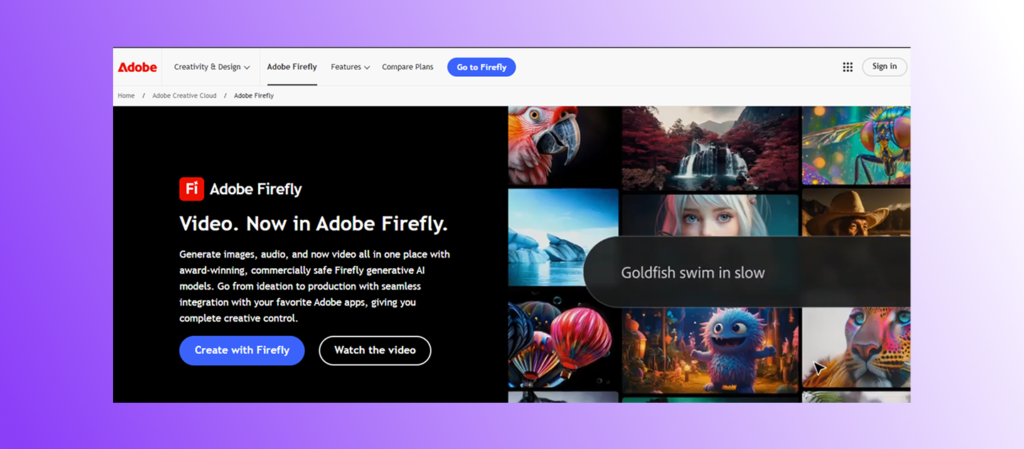
Key Features:
- Create visuals quickly by entering short and simple text prompts.
- Add or remove elements in an image with generative fill for easy editing.
- Create stylized text with different visual effects for standout typography.
- Generate video content from text or visuals with minimal editing effort.
- Keep the same voice and style when translating audio and video into new languages.
Adobe Firefly is Adobe’s dedicated AI Design Tools built to help creatives generate high-quality visuals with simple text prompts. Unlike many standalone AI generators, Firefly is deeply connected to Adobe’s ecosystem, allowing users to move smoothly between Firefly and tools like Photoshop or Illustrator. As one of the most powerful AI tools for designers, it helps bring your ideas to life quickly and easily, whether you’re creating social media graphics, product mockups, or visual concepts.
Pros of Adobe Firefly:
- Easy to use, especially for those already familiar with Adobe products.
- Works smoothly with design platforms such as Photoshop and Illustrator.
Cons of Adobe Firefly:
- Full access is available only with an Adobe Creative Cloud subscription.
- Limited support for advanced 3D or motion design (compared to other AI tools).
Adobe Firefly Pricing: Subscription options are available starting at $9.99 per month.
2. Midjourney
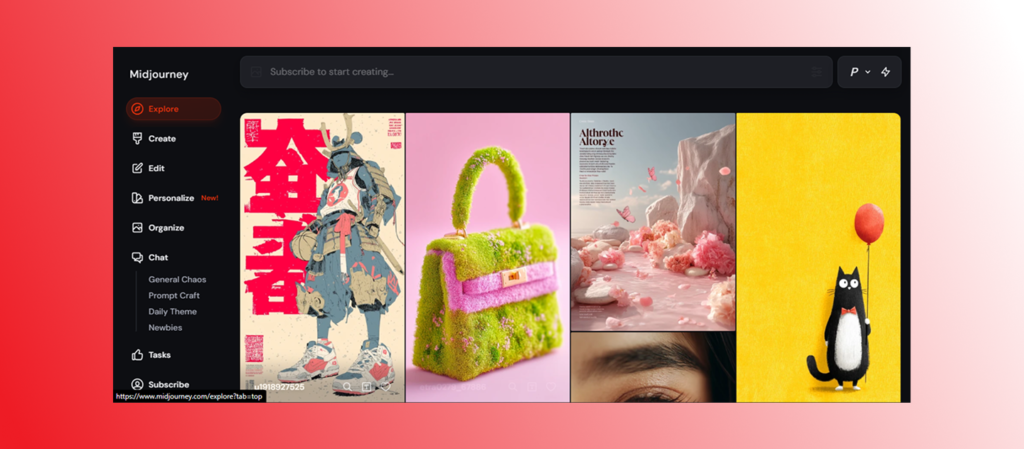
Key Features:
- Create visuals using simple text descriptions and explore multiple artistic variations.
- Adjust the output by specifying image styles, materials, lighting, and artistic influences.
- Access and collaborate through Discord for real-time creation.
Midjourney is a top-performing AI design tool that helps turn creative prompts into detailed images. This tool operates through Discord, allowing users to generate visuals simply by typing natural language prompts. As one of the most intuitive AI design tools available, it delivers impressive results—from hyper-realistic scenes to imaginative and artistic visuals. Its ease of use and creative flexibility make it a favorite among designers and artists exploring AI-powered workflows.
Pros of Midjourney:
- Generate highly realistic images with detailed control over style and composition.
- Delivers high-resolution outputs quickly for fast-paced creative work.
Cons of Midjourney:
- A limited free trial, so users must subscribe to keep using it.
Midjourney Pricing: Paid plans start from $10 per month.
3. Fontjoy
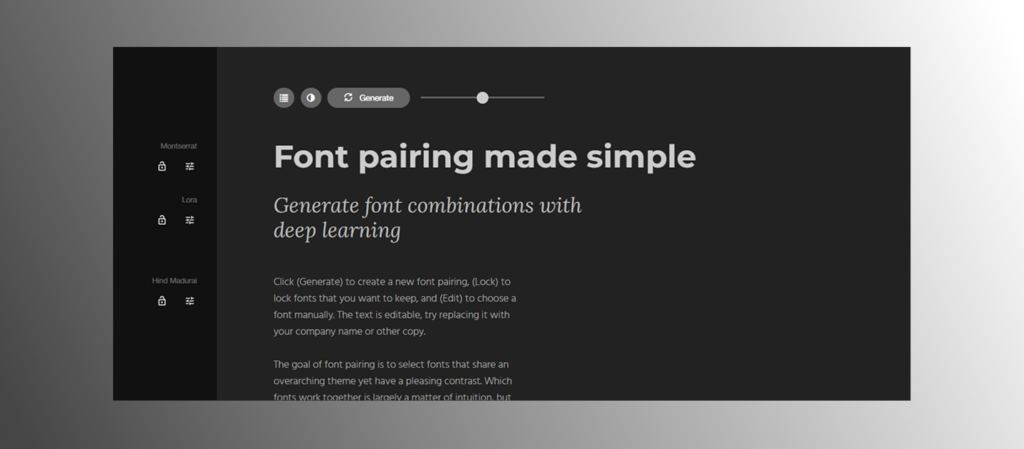
Key Features:
- Generate font pairings using AI based design tools trained on multidimensional font data.
- Adjust contrast levels between fonts to match different design needs.
- Preview font combinations with your own text to test visual impact.
Fontjoy is a designing AI tool that helps designers create visually balanced font pairings with ease. Fontjoy is one of the most accessible free AI design tools, utilizing deep learning to suggest typeface combinations based on contrast and similarity. It allows users to adjust contrast levels, lock in preferred fonts, and generate complementary matches in real time. This makes it especially valuable for UI and web design projects, where consistency and readability are essential. By leveraging AI, Fontjoy helps designers create harmonious and effective typography pairings with ease.
Pros of Fontjoy:
- Suggest font combinations with good contrast and harmony.
- Offers an interactive way to explore different typography options.
Cons of Fontjoy:
- Lacks direct export features to popular design platforms like Figma or Adobe.
Fontjoy Pricing: Free to use.
4. Leonardo.AI
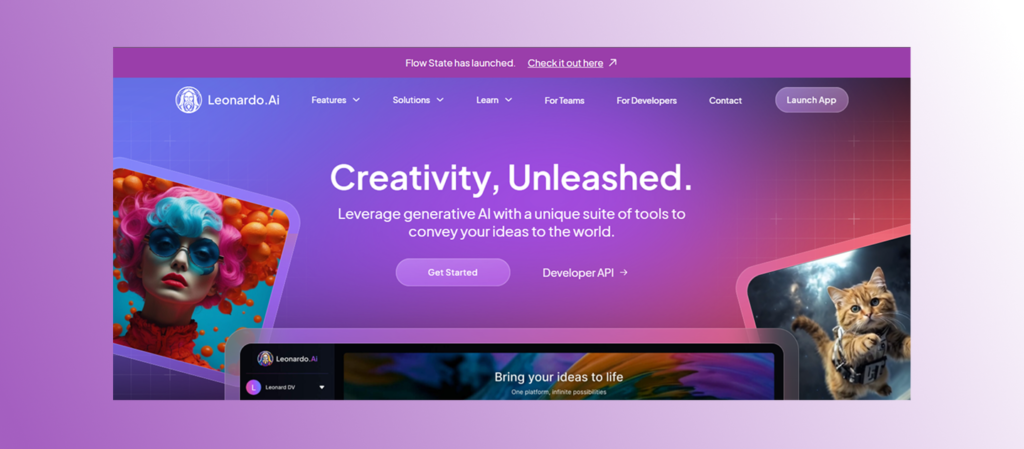
Key Features:
- Generate images using advanced AI models tailored for different artistic styles.
- Create animated content from images through an AI-based video platform.
- Create detailed 3D textures by uploading models and applying AI-generated designs.
- Edit and refine visuals directly within the platform using the AI Canvas tool.
Leonardo.ai is a powerful AI design tools that offers a suite of features enabling users to easily create images, videos, and 3D textures. Whether you’re designing concept art, game assets, or marketing materials, this AI design tool streamlines the creative process, allowing for quick ideation and execution. With its advanced capabilities, Leonardo.AI accelerates your workflow, helping you bring your ideas to life faster and more efficiently.
Pros of Leonardo.ai:
- Offers multiple AI-powered tools to support different types of creative projects.
- Offers high-quality output suitable for professional use.
- Built with an interface that is easy to navigate for users of any experience level.
Cons of Leonardo.ai:
- Advanced features could be challenging for users who lack design tool experience.
Leonardo.ai Pricing: Free plan with limited access, with paid plans starting at $12/month to unlock more features and capacity.
5. Dall-E 3
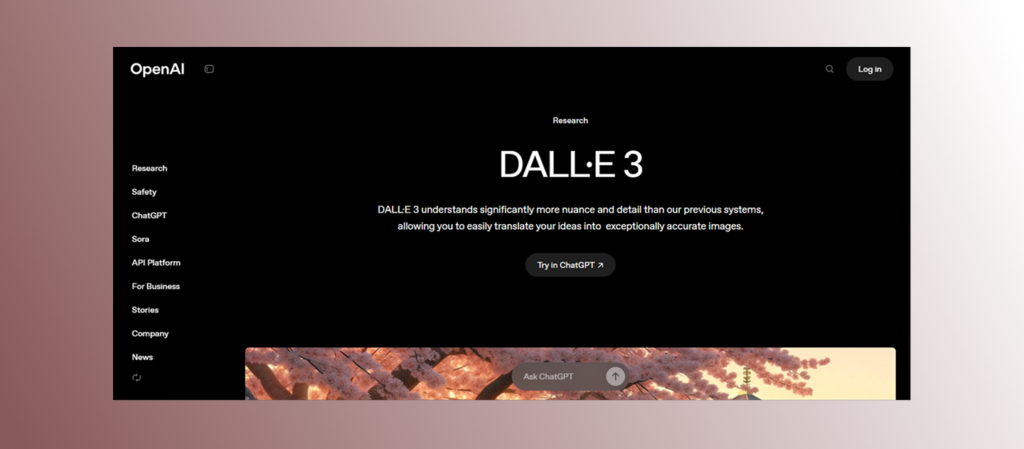
Key Features:
- Generate images from text prompts with enhanced contextual understanding.
- Refine and iterate images interactively within ChatGPT conversations.
- Produce images in various styles, including photorealistic and artistic renditions.
- Access the model through ChatGPT Plus and OpenAI’s API for broader integration.
DALL·E 3 a powerful AI design tools developed by OpenAI that generates visuals from descriptive text. What sets it apart from other AI design tools is its seamless integration with ChatGPT, allowing users to refine images interactively through direct conversation. This feature enhances the creative process, making it more intuitive and accessible, and enabling users to achieve their desired results with ease.
Pros of DALL·E 3:
- Helps users turn ideas into accurate visuals quickly without design skills.
- Understands complex and detailed prompts easily, so users can create what they imagine with less effort.
Cons of DALL·E 3:
- Access to full features requires a ChatGPT Plus subscription.
DALL·E 3 Pricing: Available through ChatGPT Plus at $20 per month, with additional API access options.
6. Luma AI
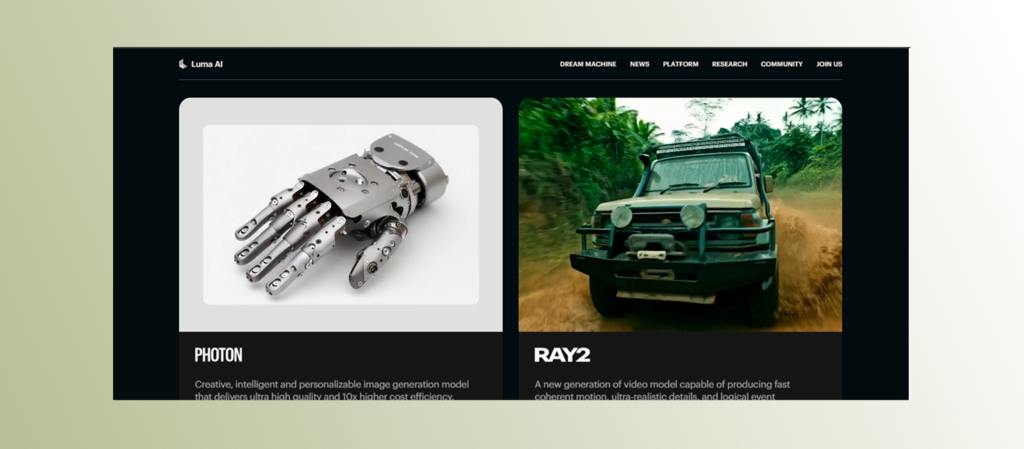
Key Features:
- Generate videos from text prompts using the Dream Machine model.
- Transform static images into dynamic videos with cinematic motion.
- Apply predefined styles and effects to customize visual outputs.
- Utilize the API for scalable and automated content generation.
Luma AI is a cutting-edge platform within AI design tools that allows creators to generate high-quality videos and 3D visuals from simple text prompts and images. Tailored for creators in media, marketing, and entertainment, it utilizes advanced AI models to simplify complex video production tasks. With features like Dream Machine and Ray2, Luma AI enables users to create realistic motion, apply cinematic effects, and easily customize outputs, streamlining the creative process.
Pros of Luma AI:
- Simplifies video creation by converting text and images into dynamic visuals.
- Offers high-quality, realistic outputs suitable for professional use.
- Provides intuitive tools that work well for both newcomers and professionals.
Cons of Luma AI:
- The free plan restricts both video duration and output quality.
Luma AI Pricing: Luma AI offers a free plan with limited features, while paid plans start from $9.99 per month, providing access to higher resolutions and additional tools.
7. Runway
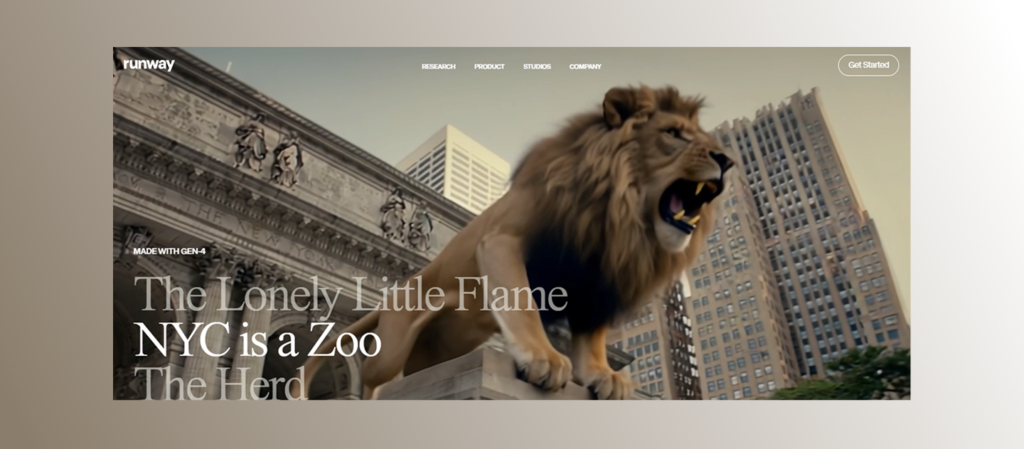
Key Features:
- Generate videos from text prompts, images, or existing videos using multimodal inputs.
- Utilize AI-powered video editing tools, including background removal, motion brush, and lip-sync capabilities.
- Integrate with other design tools to improve creative workflow efficiency.
Runway Gen-2 is an advanced AI design tool for video generation, transforming text prompts, images, or existing videos into high-quality, dynamic video content. As video continues to play a larger role in modern design workflows, Runway is quickly becoming one of the top AI design tools of 2025. Designed to support storytelling, experimentation, and fast-paced video production, it caters to everyone from marketers to filmmakers, making video creation more accessible and efficient.
4o mini
Pros of Runway Gen-2:
- Designed with simplicity in mind, making it easy to use for all types of users.
- Facilitates real-time collaboration with team workspaces, enhancing creative workflows.
- Being cloud-based, allow access from any device without the need for additional software.
Cons of Runway Gen-2:
- Requires a reliable internet connection since it runs on the cloud.
Runway Gen-2 Pricing: Runway offers a free plan with limited features, while paid plans start from $12 per user per month, providing access to higher resolutions and additional tools.
8. Haiper AI
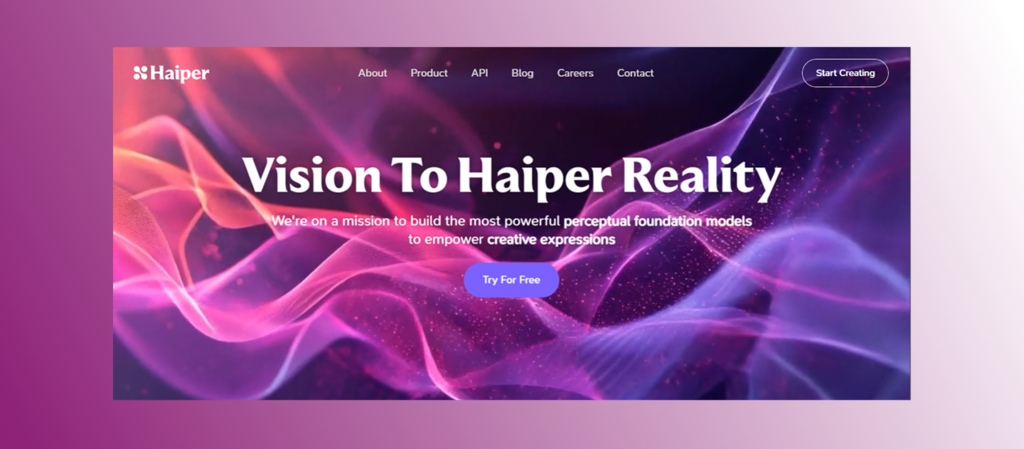
Key Features:
- Generate videos from text prompts using AI-driven models.
- Turn still images into engaging videos with built-in animation features.
- Transform existing videos with new styles and effects using the repaint feature.
- Make video editing faster and easier with built-in template options.
Haiper AI is an innovative AI design tool that transforms written prompts and visuals into captivating video content. Tailored for creators, marketers, and educators, it simplifies the video production process, allowing users to generate high-quality content without needing technical expertise. With features like text-to-video, image animation, and video repainting, Haiper AI meets a wide range of creative needs, making it a versatile addition to any workflow.
Pros of Haiper AI:
- Enables quick video creation from text or images, saving time and resources.
- Provides versatile tools for various content types, from social media posts to educational materials.
Cons of Haiper AI:
- Limited video duration in the free version.
Haiper AI Pricing: Haiper AI offers a free plan with basic features, while paid plans start from $8 per month.
9. Stability AI
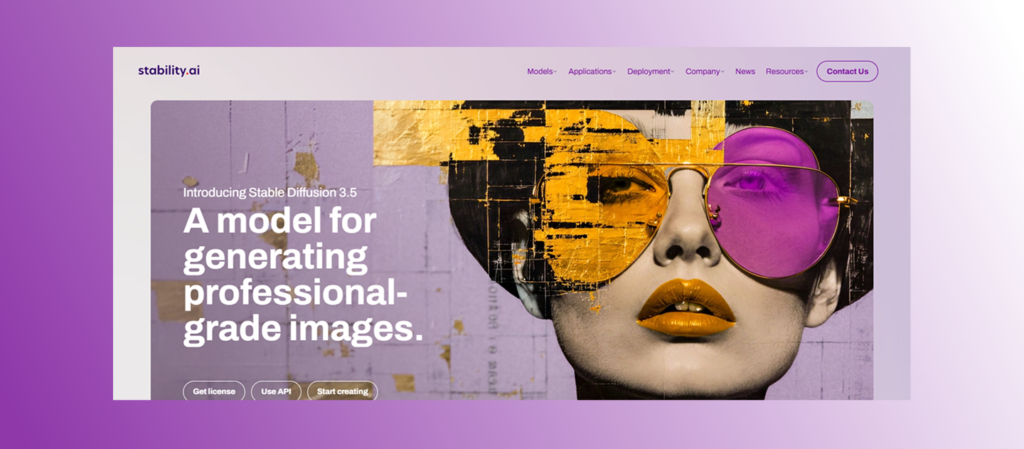
Key Features:
- Create high-resolution graphics from text input with the help of Stable Diffusion.
- Create videos from text or images with Stable Video Diffusion.
- Produce music tracks up to three minutes long using Stable Audio.
- Deploy models on-premises or integrate via API for customized workflows.
Stability AI provides a suite of open-source generative models that enable creators to produce high-quality images, videos, audio, and 3D content using simple text prompts. As one of the leading AI design tools, it empowers users to create diverse content with ease and flexibility, enhancing the creative process across various mediums.
For those looking for the best AI tool for graphic design with full control and custom workflows, Stability AI stands out thanks to its flexibility and open-source accessibility. The platform supports both cloud-based and self-hosted deployments, catering to individual creators and enterprise needs.
Pros of Stability AI:
- Handles multiple media formats to support flexible content production.
- Offers flexible deployment options, including self-hosting and API access.
Cons of Stability AI:
- Full use of advanced capabilities may depend on user’s technical skills.
- Some tools and models are still under development, with ongoing updates.
Stability AI Pricing: Stability AI offers a free tier for non-commercial use. Paid plans for commercial use start at $20 per month, with enterprise licensing available for larger organizations.
10. Animaker4 AI

Key Features:
- Turn scripts into videos using AI-powered automation and scene building.
- Create animated characters and sync them with voiceovers automatically.
- Use a wide range of templates, stock assets, and music to speed up production.
- Enable real-time teamwork through an integrated editing space.
Animaker AI is a comprehensive platform within AI design tools that empowers users to create animated and live-action videos effortlessly. Instead of starting from scratch, users can choose a template, type a script, and let the tool handle everything from animations to voiceovers. With a drag-and-drop interface, a wealth of pre-built assets, and support for over 100 languages, Animaker has become one of the most versatile AI design tools, enabling users to transform an idea into a full video in just a few simple steps.
Pros of Animaker:
- Makes video creation accessible for non-designers and beginners.
- Speeds up the editing process with ready-made templates and AI automation.
- Supports multilingual voiceovers to help reach global audiences.
Cons of Animaker:
- Some features may feel restrictive for users looking for full creative control.
Animaker Pricing: Paid plans start at $15 per month.
Final thoughts
As we progress further into 2025, the line between human creativity and artificial intelligence continues to blur—in the best way possible. The AI design tools we’ve explored are not just time-savers; they are creativity amplifiers, empowering designers to push boundaries, experiment fearlessly, and bring their visions to life faster than ever. These tools enable a new level of creative freedom and innovation, enhancing the design process like never before.
Whether you’re a solo creative, part of a design team, or building the next big product, these AI design tools are your creative allies. Embrace them, explore them, and let them enhance—not replace—your unique artistic voice. With the right balance, these tools can elevate your work, empowering you to create with greater efficiency and innovation.
The future of design isn’t just smart—it’s supercharged.

